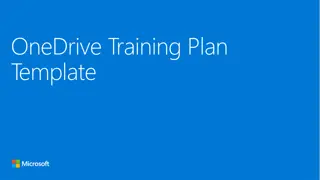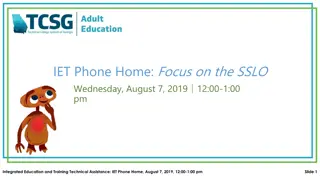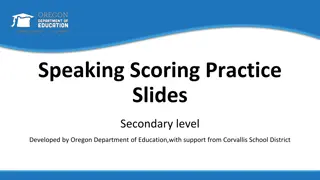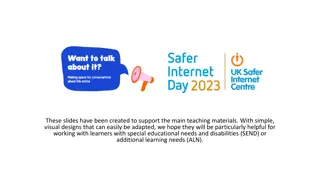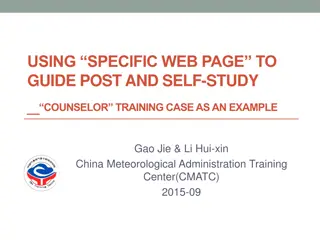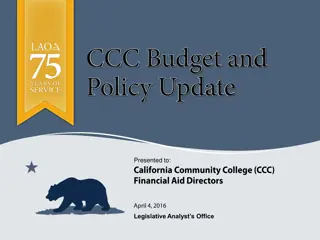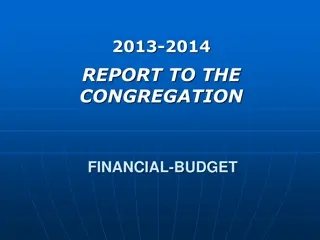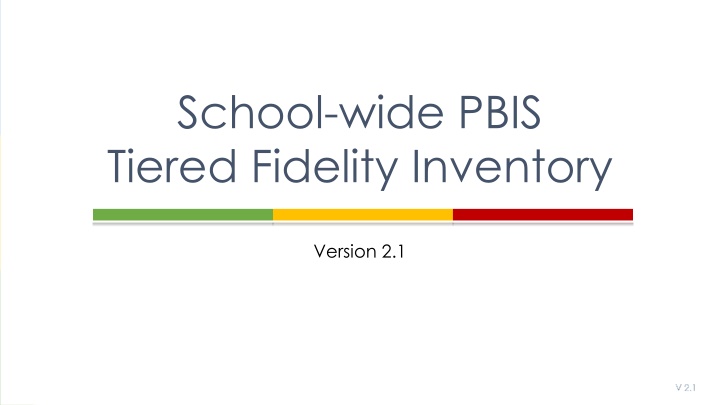
Effective Implementation of School-wide PBIS Tiered Fidelity Inventory
"Explore the purpose and administration protocol of the School-wide PBIS Tiered Fidelity Inventory to enhance PBIS core features in schools. Learn about self-assessment, team improvement, and pre-administration steps for success."
Download Presentation

Please find below an Image/Link to download the presentation.
The content on the website is provided AS IS for your information and personal use only. It may not be sold, licensed, or shared on other websites without obtaining consent from the author. If you encounter any issues during the download, it is possible that the publisher has removed the file from their server.
You are allowed to download the files provided on this website for personal or commercial use, subject to the condition that they are used lawfully. All files are the property of their respective owners.
The content on the website is provided AS IS for your information and personal use only. It may not be sold, licensed, or shared on other websites without obtaining consent from the author.
E N D
Presentation Transcript
School-wide PBIS Tiered Fidelity Inventory Version 2.1 V 2.1
Purpose of the School-wide PBIS Tiered Fidelity Inventory The purpose of the School-wide PBIS Tiered Fidelity Inventory is to provide an efficient and valid index of the extent to which PBIS core features are in place within a school. Tier I (Universal PBIS) Whole School Universal Prevention Tier II (Targeted PBIS) Secondary, Small Group Prevention Tier III (Intensive PBIS) Tertiary, Individual Support Prevention V 2.1
SWPBIS Tiered Fidelity Inventory is a Self-Assessment Primary purpose of the instrument is to help school teams improve Primary audience for instrument results is the team, faculty, families and administrators of the school. Effective use of the instrument requires multiple administrations (progress monitoring) V 2.1
Sub-subscale and Item Reports Sub-subscale Tier I Teams Implementation Evaluation Tier II Teams Interventions Evaluation Tier III Teams Resources Assessment Support plan Monitoring and adaptation Item Report Tier I Tier II 50% 40% 30% 20% 10% 0% Teams Implementation Evaluation Teams Interventions Evaluation Tier III Teams Resources Assessment Support Plan Monitoring Adaptation V 2.1
Administration Protocol School-wide PBIS Tiered Fidelity Inventory is completed by a school team with a PBIS coach/facilitator. Before Inventory Assessment: Define schedule, personnel, review existing fidelity and impact data, and obtain relevant permanent products. Conduct a building walkthrough to identify data related to the school-wide acknowledgement system. During Inventory Assessment: For each item, review purpose, data sources, and standard. All team members vote to whether the item is not implemented, partially implemented, or fully implemented. The majority vote is recorded following an opportunity for discussion. Data are recorded on pbis.assessment.org After Inventory Assessment: At least one item is identified for active action planning to improve or sustain implementation. V 2.1
Possible Pre-Administration Documentation Tier II Tier II team meeting minutes (last two) Rubric for selecting students for Tier II support Tier II strategy handbooks, or procedures (i.e., CICO) Available Tier II data summaries (if possible for 2 months) Family communication systems Most recent fidelity measures for Tier II strategies V 2.1
Subscale Feature Name Scoring Criteria 0 = Not implemented 1 = Partially implemented 2 = Fully implemented 0 = descriptors of the feature not being implemented Feature Data Sources Possible data sources Feature Name: Detailed description of the feature. 1 = descriptors of the feature being partially implemented 2 = descriptors of the feature being fully implemented Main Idea: the essence of the feature. V 2.1
Tier II School-wide PBIS Tiered Fidelity Inventory V 2.1
Subscale: Teams 2.1 Team Composition Scoring Criteria 0 = Not implemented 1 = Partially implemented 2 = Fully implemented 0 = Tier II team does not include coordinator or all 4 core areas of Tier II team expertise Feature Data Sources 2.1 Team Composition: Tier II (or combined Tier II/III) team includes a Tier II systems coordinator and individuals able to provide (a) applied behavioral expertise, (b) administrative authority, (c) knowledge of students, and (d) knowledge about operation of school across grade levels and programs. School organizational chart Tier II team meeting minutes 1 = Tier II team does not include coordinator and all 4 core areas of Tier II team expertise OR attendance of these members is below 80% 2 = Tier II team is composed of coordinator and individuals with all 4 areas of expertise, AND attendance of these members is at or above 80% Main Idea: Tier II team needs individuals with specific skills and perspectives to implement Tier II supports. V 2.1
Quick Check: Team Composition Are all necessary roles/functions represented on the team? Self-Assessment Coordinator Applied behavioral expertise Administrative authority Knowledge about students Knowledge about school operations Scoring 0 = Tier II team does not include coordinator or all 4 core areas of Tier II team expertise 1 = Tier II team does not include coordinator and all 4 core areas of Tier II team expertise OR attendance of these members is below 80% 2 = Tier II team is composed of coordinator and individuals with all 4 areas of expertise, AND attendance of these members is at or above 80% V 2.1
Item Considerations Tier II team does not need to be large. Even 2-4 people may be sufficient. The key is to ensure that the authority to make decisions exist, and the behavioral expertise is present to guide adaptations. V 2.1
Subscale: Teams 2.2 Team Operating Procedures Scoring Criteria 0 = Not implemented 1 = Partially implemented 2 = Fully implemented 0 = Tier II team does not use regular meeting format/agenda, minutes, defined roles, or a current action plan Feature Data Sources 2.2 Team Operating Procedures: Tier II team meets at least monthly and has (a) regular meeting format/agenda, (b) minutes, (c) defined meeting roles, and (d) a current action plan. Tier II team meeting agendas and minutes Tier II meeting roles descriptions Tier II action plan 1= Tier II team has at least 2 but not all 4 features 2 = Tier II team meets at least monthly and uses regular meeting format/agenda, minutes, defined roles, AND has a current action plan Main Idea: Tier II teams need meeting foundations in order operate efficiently and to implement effective supports. V 2.1
Quick Check: Team Operating Procedures What meeting procedures are currently in place at the Tier II level? Self-Assessment Regular, monthly meetings Consistently followed meeting format Minutes taken during and disseminated after each meeting (or at least action plan items are disseminated) Participant roles are clearly defined Action plan current to the school year Scoring 0 = Tier II team does not use regular meeting format/agenda, minutes, defined roles, or a current action plan 1= Tier II team has at least 2 but not all 4 features 2 = Tier II team meets at least monthly and uses regular meeting format/agenda, minutes, defined roles, AND has a current action plan V 2.1
Item Considerations Tier II team may be part of Tier I team, but a regular meeting typically is needed to review Tier II data, and needed for new students nominated for Tier II. Clarify with teams if and how the decision is made to transition from Tier I meeting items to Tier II meeting items. V 2.1
Subscale: Teams 2.3 Screening Scoring Criteria 0 = Not implemented 1 = Partially implemented 2 = Fully implemented 0 = No specific rules for identifying students who qualify for Tier II supports Feature Data Sources 2.3 Screening: Tier II team uses decision rules and multiple sources of data (e.g., ODRs, academic progress, screening tools, attendance, teacher/family/student nominations) to identify students who require Tier II supports. Multiple data sources used (ODRs/Time out of instruction, Attendance, Academic performance) Team Decision Rubric Team meeting minutes School Policy 1 = Data decision rules established but not consistently followed or used with only one data source 2 = Written policy exists that (a) uses multiple data sources for identifying students, and (b) ensures that families are notified when a student enters Tier II supports Main Idea: Timely selection of students for Tier II supports improves the effectiveness of Tier II implementation. V 2.1
Quick Check: Screening What is the process for identifying students who may need Tier II supports? Self-Assessment Written policy or rubric for identifying students in need of assistance Multiple data sources Process for notifying and including families Scoring 0 = No specific rules for identifying students who qualify for Tier II supports 1 = Data decision rules established but not consistently followed or used with only one data source 2 = Written policy exists that (a) uses multiple data sources for identifying students, and (b) ensures that families are notified when a student enters Tier II supports V 2.1
Subscale: Teams 2.4 Request for Assistance Scoring Criteria 0 = Not implemented 1 = Partially implemented 2 = Fully implemented 0 = No formal process Feature Data Sources 2.4 Request for Assistance: Tier II planning team uses written request for assistance form and process that are available to all staff, families, and students. School Handbook Request for Assistance Form Family Handbook 1 = Informal process in place for staff and families to request behavioral assistance 2 = Written request for assistance process is in place and team responds to request within 3 days Main Idea: Faculty, staff, families should have a highly predictable, and low-effort strategy for requesting behavior assistance. V 2.1
Quick Check: Request for Assistance What is the process for requesting assistance with behavior support? Self-Assessment Written policy or rubric for identifying students in need of assistance Multiple data sources Process for notifying and including families Scoring 0 = No formal process 1 = Informal process in place for staff and families to request behavioral assistance 2 = Written request for assistance process is in place and team responds to request within 3 days V 2.1
Item Considerations The process for nominating a student should be easily understood and easily accessed by all. Families should know how to nominate a student and know the process when a student is nominated. Emphasis should be given on the success of the process when done early. V 2.1
Subscale: Interventions 2.5 Sufficient Array of Tier II Interventions Scoring Criteria 0 = Not implemented 1 = Partially implemented 2 = Fully implemented 0 = No Tier II interventions with documented evidence of effectiveness are in use Feature Data Sources 2.5 Sufficient Array of Tier II Interventions: Tier II team has multiple ongoing behavior support interventions with documented evidence of effectiveness matched to student need. School Tier II Handbook Targeted Interventions Reference Guide 1 = Only 1 Tier II intervention with documented evidence of effectiveness is in use 2 = Multiple Tier II interventions with documented evidence of effectiveness matched to student need Main Idea: A wide array of intervention options increases the likelihood that student needs are met and done so in a timely way. V 2.1
Quick Check: Sufficient Array of Tier II Interventions What intervention options are available at the Tier II level? Self-Assessment Are there multiple Tier II interventions readily available? Do they have an evidence base of effectiveness with students? Scoring 0 = No Tier II interventions with documented evidence of effectiveness are in use 1 = Only 1 Tier II intervention with documented evidence of effectiveness is in use 2 = Multiple Tier II interventions with documented evidence of effectiveness matched to student need V 2.1
Item Considerations Standard modifications of existing interventions meet the criteria for sufficient array. CICO for peer attention CICO for academic task avoidance Many approaches for Tier II support Focus on Tier II supports that improve student success (e.g., do more than simply remove or control the student) Combinations of support strategies may be very appropriate and efficient. V 2.1
Subscale: Interventions 2.6 Tier II Critical Features Scoring Criteria 0 = Not implemented 1 = Partially implemented 2 = Fully implemented 0 = Tier II interventions do not promote additional instruction/time, improved structure, or increased feedback Feature Data Sources 2.6 Tier II Critical Features: Tier II behavior support interventions provide (a) additional instruction/time for student skill development, (b) additional structure/predictability, and/or (c) increased opportunity for feedback (e.g., daily progress report). Universal lesson plans Tier II lesson plans Daily/weekly progress report School schedule School Tier II handbook 1 = All Tier II interventions provide some but not all 3 core Tier II features 2 = All Tier II interventions include all 3 core Tier II features Main Idea: Tier II supports should focus on improving the skills and context needed for student success. V 2.1
Quick Check: Tier II Critical Features What critical features are embedded in Tier II supports? Self-Assessment Do all Tier II interventions include additional instruction/time for student skill development? Do all Tier II interventions include additional structure/predictability? Do all Tier II interventions include increased opportunities for feedback? Scoring 0 = Tier II interventions do not promote additional instruction/time, improved structure, or increased feedback 1 = All Tier II interventions provide some but not all 3 core Tier II features 2 = All Tier II interventions include all 3 core Tier II features V 2.1
Subscale: Interventions 2.7 Practices Matched to Student Need Scoring Criteria 0 = Not implemented 1 = Partially implemented 2 = Fully implemented 0 = No process in place Feature Data Sources 2.7 Practices Matched to Student Need: A formal process is in place to select Tier II interventions that are (a) matched to student need (e.g., behavioral function), and (b) adapted to improve contextual fit (e.g., culture, developmental level). Data sources used to identify interventions School Policy Tier II Handbook Needs assessment Targeted Interventions Reference Guide 1 = Process for selecting Tier II interventions does not include documentation that interventions are matched to student need 2 = Formal process in place to select practices that match student need and have contextual fit (e.g., developmentally and culturally appropriate) Main Idea: Tier II support strategies are evidence-based, and designed with preliminary assessment information (or assumptions) about student need. V 2.1
Quick Check: Practices Matched to Student Need What is the process for identifying appropriate Tier II supports? Self-Assessment Is there a formalized process to select Tier II supports? Does the process take into account student need and contextual fit? Scoring 0 = No process in place 1 = Process for selecting Tier II interventions does not include documentation that interventions are matched to student need 2 = Formal process in place to select practices that match student need and have contextual fit (e.g., developmentally and culturally appropriate V 2.1
Subscale: Interventions 2.8 Access to Tier I Supports Scoring Criteria 0 = Not implemented 1 = Partially implemented 2 = Fully implemented 0 = No evidence that students receiving Tier II interventions have access to Tier I supports Feature Data Sources 2.8 Access to Tier I Supports: Tier II supports are explicitly linked to Tier I supports, and students receiving Tier II supports have access to, and are included in, Tier I supports. Universal Lesson plans & teaching schedule Acknowledgement system Student of the month documentation Family communication 1 = Tier II supports are not explicitly linked to Tier I supports and/or students receiving Tier II interventions have some, but not full access to Tier I supports 2 = Tier II supports are explicitly linked to Tier I supports, and students receiving Tier II interventions have full access to all Tier I supports Main Idea: Tier II supports are more effective when layered within Tier I. V 2.1
Quick Check: Access to Tier I Supports How do students receiving Tier II supports benefit from the Tier I system? Self-Assessment Are the school s Tier II supports linked/layered/aligned with the school-wide, universal system? Do students receiving Tier II supports still receive full access to Tier I systems? Scoring 0 = No evidence that students receiving Tier II interventions have access to Tier I supports 1 = Tier II supports are not explicitly linked to Tier I supports and/or students receiving Tier II interventions have some, but not full access to Tier I supports 2 = Tier II supports are explicitly linked to Tier I supports, and students receiving Tier II interventions have full access to all Tier I supports V 2.1
Subscale: Interventions 2.9 Professional Development Scoring Criteria 0 = Not implemented 1 = Partially implemented 2 = Fully implemented 0 = No process for teaching staff in place Feature Data Sources 2.9 Professional Development: A written process is followed for teaching all relevant staff how to refer students and implement each Tier II intervention that is in place. Professional Development Calendar Staff Handbook Lesson plans for teacher trainings School policy 1 = Professional development and orientation process is informal 2 = Written process used to teach and coach all relevant staff in all aspects of intervention delivery, including request for assistance process, using progress report as an instructional prompt, delivering feedback, and monitoring student progress Main Idea: Effective Tier II supports require participation of many adults in the school. V 2.1
Quick Check: Professional Development What is the process for training staff members providing Tier II supports? Self-Assessment Are there scheduled trainings for school team members? Is there a faculty-wide orientation led by the Tier II Team? Is there a scheduled annual orientation for new faculty? Are there documented strategies for orienting substitutes or volunteers? Is the process for requesting assistance around behavioral concerns known by all, easy to follow, and encouraged? Scoring 0 = No process for teaching staff in place 1 = Professional development and orientation process is informal 2 = Written process used to teach and coach all relevant staff in all aspects of intervention delivery, including request for assistance process, using progress report as an instructional prompt, delivering feedback, and monitoring student progress V 2.1
Subscale: Evaluation 2.10 Level of Use Scoring Criteria 0 = Not implemented 1 = Partially implemented 2 = Fully implemented 0 = Team does not track number of students responding to Tier II interventions Feature Data Sources 2.10 Level of Use: Team follows written process to track proportion of students participating in Tier II supports, and access is proportionate. Tier II enrollment data Tier II team meeting minutes Progress monitoring tool 1 = Student data monitored but no data decision rules established to alter (e.g., intensify or fade) support 2 = Team defines criteria and tracks proportion, with at least 5% of students receiving Tier II supports Main Idea: Tier II supports that are used too little (e.g. 1%) or too much (e.g. 20%) are not sustainable. V 2.1
Quick Check: Level of Use What proportion of students are receiving Tier II supports? Self-Assessment Is at least 5% of the total population receiving Tier II supports? Does the school have the capacity to sustain effective supports for this proportion of students? Scoring 0 = Team does not track number of students responding to Tier II interventions 1 = Student data monitored but no data decision rules established to alter (e.g., intensify or fade) support 2 = Team defines criteria and tracks proportion, with at least 5% of students receiving Tier II supports V 2.1
Item Considerations Tier II team and administration should know the proportion of students on Tier II supports. The level of Tier II supports should be between 3% and 17% to be effective and worth the organizational costs. At least 70% of students should succeed on initial Tier II supports. If lower, consider if Tier III supports are missing, or ineffective. V 2.1
Subscale: Evaluation 2.11 Student Performance Data Scoring Criteria 0 = Not implemented 1 = Partially implemented 2 = Fully implemented 0 = Student data not monitored Feature Data Sources 2.11 Student Performance Data: Tier II team tracks proportion of students experiencing success (% of participating students being successful) and uses Tier II intervention outcomes data and decision rules for progress monitoring and modification. Student progress data (e.g., % of students meeting goals) Intervention Tracking Tool Daily/Weekly Progress Report sheets Family communication 1 = Student data monitored but no data decision rules established to alter (e.g., intensify or fade) support 2 = Student data (% of students being successful) monitored and used at least monthly , with data decision rules established to alter (e.g., intensify or fade) support, and shared with stakeholders Main Idea: Tier II team needs regular access to information about student success to be able to adapt and improve Tier II supports. V 2.1
Quick Check: Student Performance Data How is Tier II outcome data used to provide effective supports? Self-Assessment Is there a system to collect and organize intervention outcome data? Does the Tier II team have access to reports summarizing intervention outcome data? Does the Tier II team have a system with data decision rules to identify how Tier II supports should be altered? Scoring 0 = Student data not monitored 1 = Student data monitored but no data decision rules established to alter (e.g., intensify or fade) support 2 = Student data (% of students being successful) monitored and used at least monthly , with data decision rules established to alter (e.g., intensify or fade) support, and shared with stakeholders V 2.1
Subscale: Evaluation 2.12 Fidelity Data Scoring Criteria 0 = Not implemented 1 = Partially implemented 2 = Fully implemented 0 = Fidelity data are not collected for any practice Feature Data Sources 2.12 Fidelity Data: Tier II team has a protocol for on-going review of fidelity for each Tier II practice. Tier II coordinator training District technical assistance Fidelity probes taken monthly by a Tier II team member 1 = Fidelity data (e.g., direct, self- report) collected for some but not all Tier II interventions 2 = Periodic, direct assessments of fidelity collected by Tier II team for all Tier II interventions Main Idea: Fidelity assessments should always be included as part of implementation practice. V 2.1
Quick Check: Fidelity Data What role does fidelity data play in the actions of the Tier II team? Self-Assessment Is the team assessing fidelity of implementation at Tier II? Is there regular assessment of fidelity? Are the fidelity data used for decision making and action planning at Tier II? Scoring 0 = Fidelity data are not collected for any practice 1 = Fidelity data (e.g., direct, self-report) collected for some but not all Tier II interventions 2 = Periodic, direct assessments of fidelity collected by Tier II team for all Tier II interventions V 2.1
Subscale: Evaluation 2.13 Evaluation Scoring Criteria 0 = Not implemented 1 = Partially implemented 2 = Fully implemented 0 = No data-based evaluation takes place Feature Data Sources 2.13 Annual Evaluation: At least annually, Tier II team assesses overall effectiveness and efficiency of strategies, including data- decision rules to identify students, range of interventions available, fidelity of implementation, and on-going support to implementers, and evaluations are shared with staff and district leadership. Staff and student surveys Tier II handbook Fidelity tools School Policy Student outcomes District Reports 1 = Evaluation conducted, outcomes not used to shape the Tier II process 2 = Evaluation conducted at least annually, and outcomes shared with staff and district leadership, clear alterations in process proposed based on evaluation Main Idea: Any strategy or procedure needs to be reviewed at least annually and revised to remain current and match changes in the school. V 2.1
Quick Check: Evaluation What is the process for regularly examining Tier II systems? Self-Assessment Is there an evaluation conducted for Tier II systems? Does this happen annually? Are the outcomes shared with all stakeholders (faculty, students, family, board members, superintendent, etc.)? Are the outcomes clearly linked to a Tier II action plan? Scoring 0 = No data-based evaluation takes place 1 = Evaluation conducted, outcomes not used to shape the Tier II process 2 = Evaluation conducted at least annually, and outcomes shared with staff and district leadership, clear alterations in process proposed based on evaluation V 2.1







